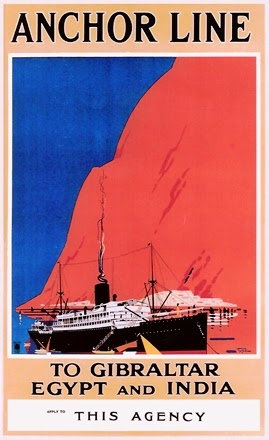Bill Miller writes about the old Scottish steamship company Anchor Line, of Glasgow:
"The
smell of curry! "They were said to
be the best kept, most immaculate passenger ships using the port of Liverpool
in the 1950s & '60s," said Mike McDougle, who served aboard Britain's
long-gone Anchor Line and aboard the Company's three, 11,000-ton passenger
ships, the Caledonia, Cilicia &
Circassia, which carried up to 300 one-class passengers each. "We were on the Indian run – sailing by
way of Gibraltar, Port Said and the Suez Canal to Karachi and, the final stop,
to Bombay. We carried very few tourists
actually, but mostly government people, lots of the old colonials, businessmen,
tea merchants and Indians including the occasional maharaja. Those Indian princes traveled with entire
entourages that occupied as many as a dozen cabins onboard. One royal, I think it was the Maharaja of
Rawalpindi, had a stateroom just for his pet falcon."
"These
Anchor liners were famed for their cuisine," added Mike. "They had all-Indian galley crews that
prepared the most wonderful curries.
Just having, say, lunch aboard at Liverpool was a treat. Anchor Line food was equal to the finest
Indian restaurant. Anchor was also noted
for its exceptional maintenance and shipboard care. Everything, even the engine room, was in pristine
condition. Even though these ships were
over 20 years of age, it was as if they'd just left the shipyard."
+colec%C3%A7%C3%A3o+L.M.Correia.jpg) Luís Miguel Correia end note: In Portugal the Companhia Colonial de Navegação had an unofficial link to Anchor Line in two ways:
Luís Miguel Correia end note: In Portugal the Companhia Colonial de Navegação had an unofficial link to Anchor Line in two ways: In 1929 CCN purchased from Anchor Line the liner ASSYRIA and as the COLONIAL she served under the Portuguese colours until sold for breaking up in 1950.
Then at the end of WW2 an agreement between the Governments of Portugal and Great Britain gave priority to the building of merchant ships in British yards for Portuguese owners. CCN ordered two fine 13 000 grt passenger liners from John Brown of Clydebank, the PÁTRIA, delivered in December 1947 and the IMPÉRIO, delivered six months later while the rival Companhia Nacional de Navegação (CNN) ordered two passenger motor ships of similar size but of more modern design from Newcastle yards, the sisters ANGOLA and MOÇAMBIQUE.
 The CCN pair was built and delivered one years in advance of the Nacional sisters mainly because instead of designing the PÁTRIA and IMPÉRIO from scratch, original plans developed by John Brown for Anchor Line before WW2 were used and adapted to Cia. Colonial requirements. This saved a full year and in fact The Colonial sisters were very similar in terms of exterior design to the Anchor final three passenger liners.
The CCN pair was built and delivered one years in advance of the Nacional sisters mainly because instead of designing the PÁTRIA and IMPÉRIO from scratch, original plans developed by John Brown for Anchor Line before WW2 were used and adapted to Cia. Colonial requirements. This saved a full year and in fact The Colonial sisters were very similar in terms of exterior design to the Anchor final three passenger liners.
Built for the Lisbon-East Africa passenger and mail service, the PÁTRIA and the IMPÉRIO only made one voyage each homebound by Suez, the IMPÉRIO in the 1950s and the PÁTRIA in 1962 when she sailed from Mozambique for Karachi and then home to Lisbon.
Further to the official mail service, the Portuguese liners also cruised from time to time and also used to embark in Cape Town and Durban tourists from South Africa for the round coastal trip up to Mozambique and back, using the first class cabins alloted to passenger from Angola and left vacant after the ships sailed South from Moçamedes.
There was always a group of South African cruise passengers aboard when the ships sailed the Indian Ocean and often there was occasion for romance between young Portuguese ship officers and S.A. pretty girls, some giving way to weddings.
There was always a group of South African cruise passengers aboard when the ships sailed the Indian Ocean and often there was occasion for romance between young Portuguese ship officers and S.A. pretty girls, some giving way to weddings.
Texto e imagens /Text and images copyright L.M.Correia. Favor não piratear. Respeite o meu trabalho / No piracy, please. For other posts and images, check our archive at the right column of the main page. Click on the photos to see them enlarged. Thanks for your visit and comments. Luís Miguel Correia

No comments:
Post a Comment